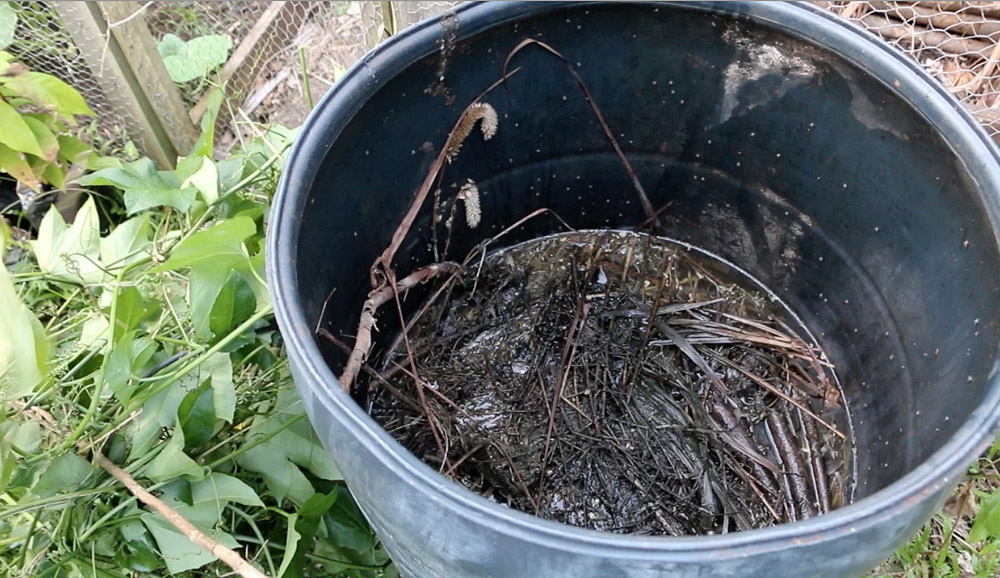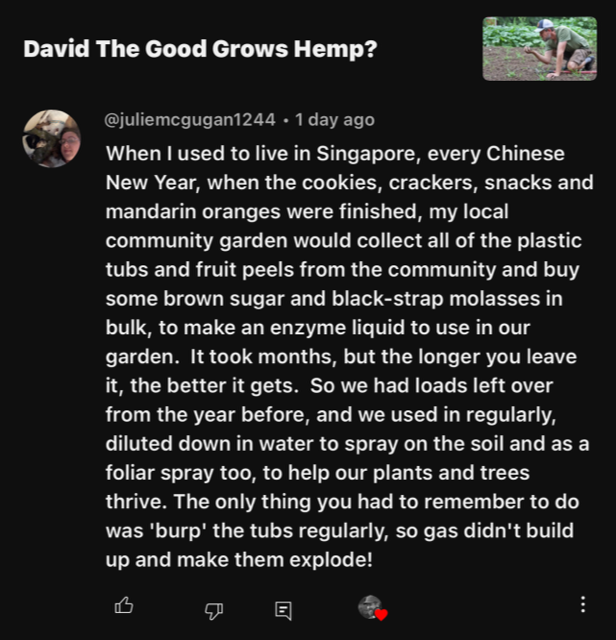Julie shares about her experience with making fetid swamp water in Singapore:
When I used to live in Singapore, every Chinese New Year, when the cookies, crackers, snacks and mandarin oranges were finished, my local community garden would collect all of the plastic tubs and fruit peels from the community and buy some brown sugar and black-strap molasses in bulk, to make an enzyme liquid to use in our garden. It took months, but the longer you leave it, the better it gets. So we had loads left over from the year before, and we used in regularly, diluted down in water to spray on the soil and as a foliar spray too, to help our plants and trees thrive. The only thing you had to remember to do was ‘burp’ the tubs regularly, so gas didn’t build up and make them explode!
That comment was posted below my video on growing sunn hemp.
The JADAM version of Korean Natural Farming practiced by Youngsang Cho does not use sugars in fermentation; however, we have seen others use it, just as Julie relates.
Anaerobic composting isn’t the devil it’s made out to be. It can be very useful, especially when you have limited resources and wish to make the most of a small amount of fertile materials.
Of course, if you take the Dave’s Fetid Swamp Water approach and start using your anaerobic “tea” only a couple of weeks after you start the fermentation process, the stench is incredible.
It creates an aroma so thick you can feel the clouds of odor pressing against your body as you walk through the garden, which then condense into sulfurous snakes that creep directly through your nostrils into your brain.
If you get it on your hands, woe unto thee!
The noxious fumes persist for a day or more on the skin, even after scrubbing your way through a fresh bar of Zest. If you caress your spouse’s hair, she’ll recoil in horror and wonder if you are a reanimated corpse instead of the man she married. If you pet a puppy, it will burst into flames, giving you a memory you’ll recall with shame and horror for the rest of your life.
It’s that bad.
Yet plants don’t have noses and they do just fine with it, happily growing amidst the fumes.
It’s much better if you wait longer to use it, until it’s burned off the worst of the aromas. And if the Singaporeans are right, it just gets better for the garden.
I’ve smelled year-old swamp water made from fish guts and it was not unpleasant. I’ve also had a batch of mixed manure and weeds and other materials (including chicken guts) that mellowed out into a mild soy sauce aroma.
All this reminds me – it’s almost spring and we need to make a batch.
(You can learn more about “Dave’s Fetid Swamp Water” in Compost Everything.)



2 comments
For indoor and small scale gardens, I’ve been making something similar to your fetid swamp water by filling plastic bottles with various food scraps, including meat, dairy, and bones – and adding water so that it’s roughly half water, a quarter scraps, and a quarter air.
I then squeeze out the remaining air and put the lid on tight, as the bottle will expand as the anaerobic scraps decompose.
I’ve tried using bottles that have aged for a month, and bottles that have aged for two years, and it is a wonderful organic fertilizer! Just be careful not to try it with glass bottles (as I learned the hard way), and if you want to use it indoors, let it air outside for a bit before you dilute it, to let most of the gases escape, and it won’t smell nearly as bad.
That’s a fun way to do it.
Comments are closed.